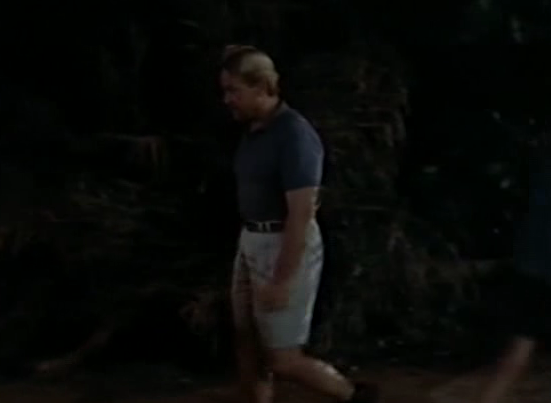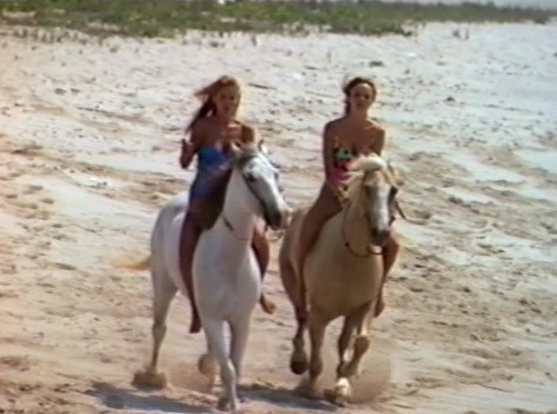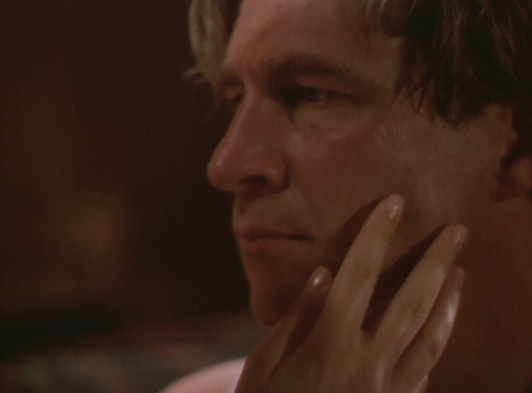This review has been posted in conjunction with the Daily Grindhouse's year long tribute to the USA World Premiere Movie.
Strange But True: Mike Farrell, who stars in Sins of the Mind, co-wrote the muddled, but oh-so-70s jiggly-tastic TV movie Ebony, Ivory and Jade (starring Bert Convy, no less!).
Not That Strange but Still True: Farrell served as an executive producer on this USA Original film.
And Totally Strange and Probably Not True: If you go by the logic of Sins of the Mind, hot girls who get hit on the head become sex addicts.
OK, I am pretty sure that last statement is patently false, but it made for a good hook, and leads me to my review of the wild, weird, and intriguing Sins of the Mind; a movie that was not even registered on my small screen lovin’ radar until recently, when Kent from the Movies About Girls podcast mentioned it on one of the shows (he told me it was must see TV). When I saw it was a USA Original I thought, “Hey, I can exploit this tidbit for my own purposes.” And here we are. So let’s get started:
But that’s (almost) not what Sins is about. Sure, there’s plenty of the tawdry to be found – Michelle becomes a prostitute for a spell and also has to attend a group therapy session full of rapists and other seamy types. The other “sin” Sins is commenting on is that of the illusory suburban family ideal. On the surface it would seem the household is merely blind to Michelle’s erratic nature, but as the film progresses, it becomes more and more obvious that they simply do not want to deal with the issues Michelle’s problems bring into the family. From raging sibling jealousy to a “live by my rules or get out of the house” discipline style, Michelle is lost in a family that desperately aches to exist inside a Norman Rockwell painting.
In fact, Rockwell is name dropped during an intense dinner scene. While Michelle and her “Uncle” Frank (Robert Pine, giving off a sleaze vibe early on) squirm in their seats after being discovered in the act by Michelle’s sister Allegra (Cyia Batten, of the Pussycat Dolls!), the parents continue to eat, drink and be merry until Allegra finally stomps off in disgust - a moment which cannot be ignored.
This would seem to be the makings of solid soap storytelling if it were not for the fact that Sins is touted as a true story. And that’s where it all goes hinky, folks. The performances are top notch, with Mike Farrell (who signed on first as a producer and had not intended to appear in the film) and Jill Clayburgh bringing home the bacon, adding depth to a fairly ludicrous situation (I was squealing “Oh my god!” at various moments - in a good way). Unfortunately, there is a lingering air of - for lack of better words - women hate. It’s not misogynistic; Sins does its best to make us feel for Michelle and even though she longs to be an object of desire, she is never treated by the film as an object of ridicule. But she is only redeemed through the love of her father, the help of a male psychiatrist (which might not seem unusual, except the female psychiatrist proves to be utterly worthless), and the understanding of other males who just happen to be sex offenders! The mother and sister are portrayed as virtuous but petty and, if you are Jill Clayburgh, sometimes drunk. Yes, we get it, in Middle America alcoholics are more acceptable than sexaholics. It is unfortunate that Michelle finally learns to circumvent the longing for male desire, but constantly turns to men for other forms of support.
That said, Sins is one damn good watch. As I said earlier, the acting is fantastic, and Crider is phenomenal in the lead role. She is childish, vampy and confused all at once. The bigger her hair gets, the worse off she is (thank you, nineties TV). Aside from a few questionable moments (hey, is that a nymphomaniac sitting on her daddy’s lap?), she remains a captivating and sympathetic character.
Sins is directed with sensitivity (and an ability to create a salacious TV-PG scenario) by the great James Frawley, that man behind The Muppet Movie, and many episodes of The Monkees. He, and screenwriter Sharon Elizabeth Doyle do a commendable job of creating a metaphor out of Michelle’s sex addiction, making it feel less sleazy than it probably should have.
And one last random fact: Sins, which aired on June 11th, 1997, ran against a rerun of Bionic Ever After?
Life is strange sometimes. Make it stranger and watch Sins.























































































































































































